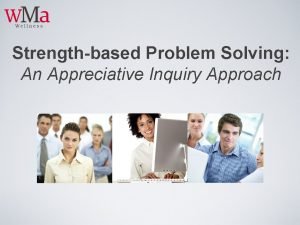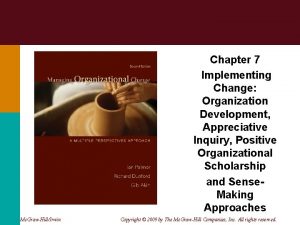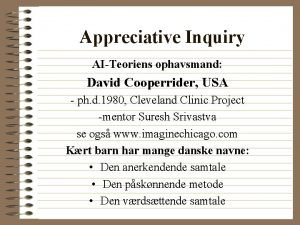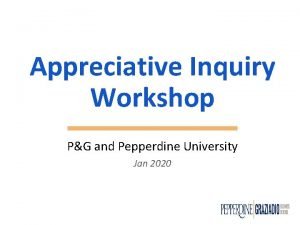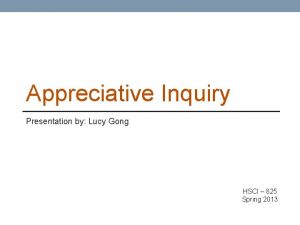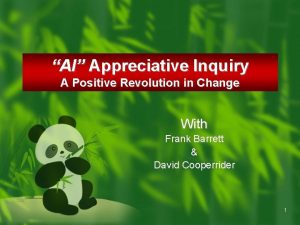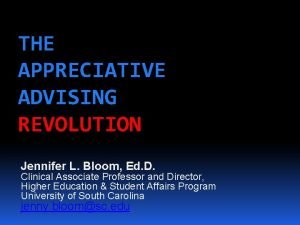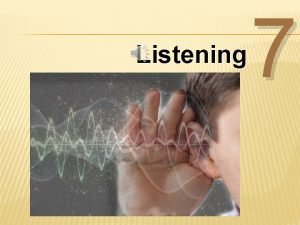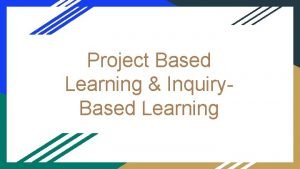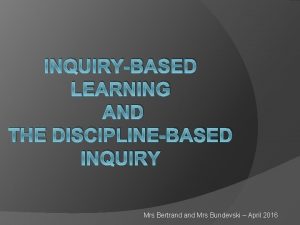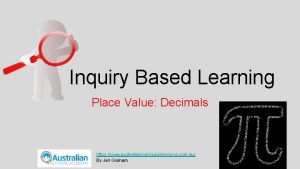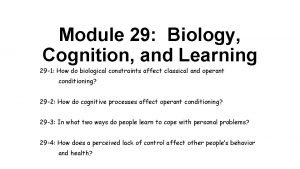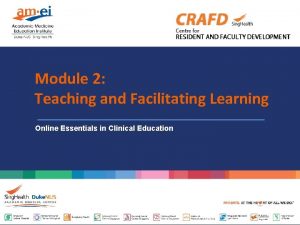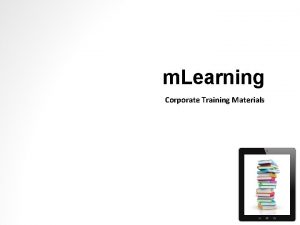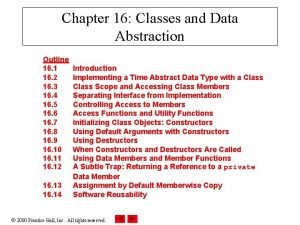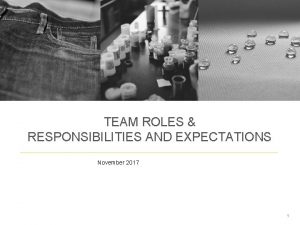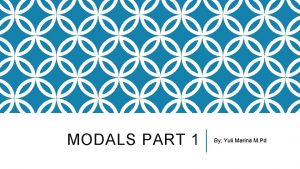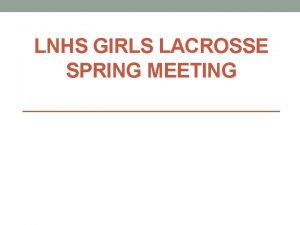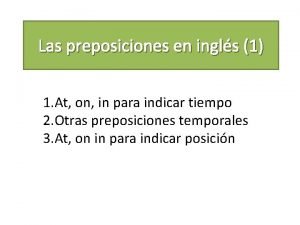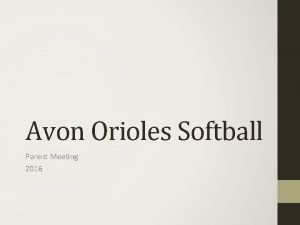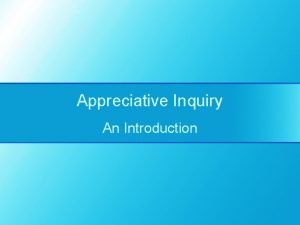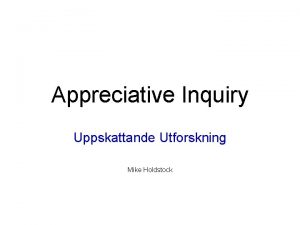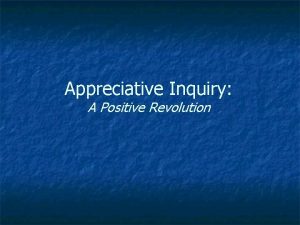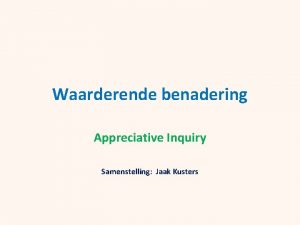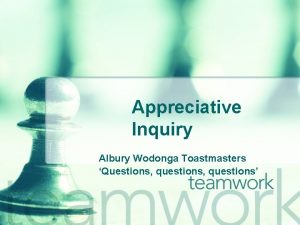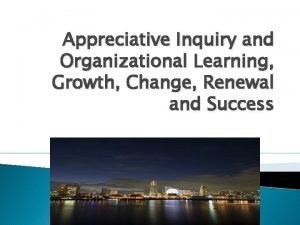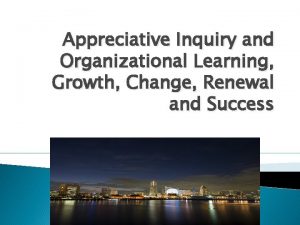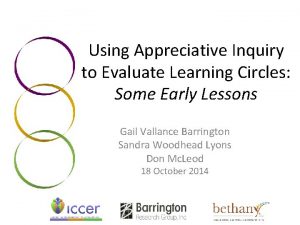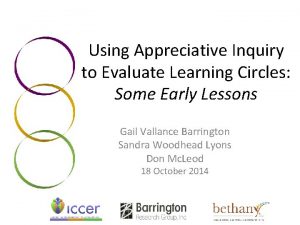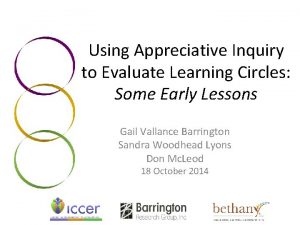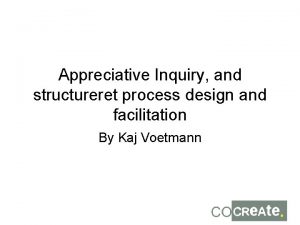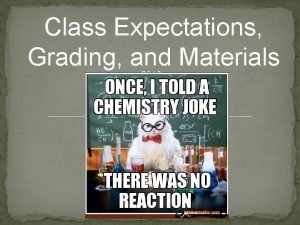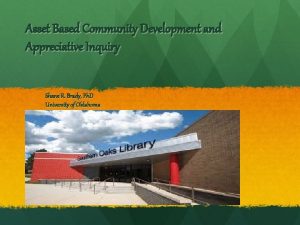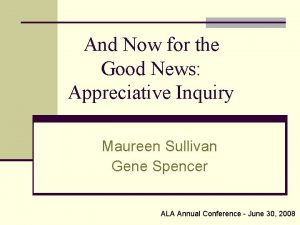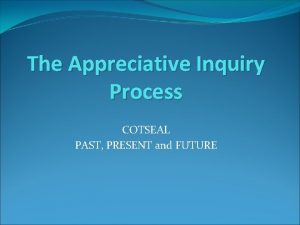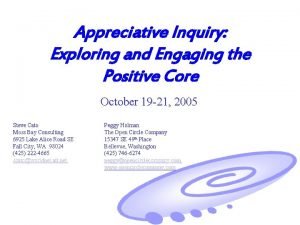Module Two Appreciative Inquiry Expectations and Learning 1






































- Slides: 38

Module Two Appreciative Inquiry, Expectations, and Learning 1

Key Elements in this Module • Expectations and Self-fulfilling Prophecy • Dialogue about learning -- goals, context, process and content – toward a psychological contact • Learning styles • Cognitive development • Experiential learning – Learning-by-doing • Appreciative inquiry 2

Expectations: Some Definitions • Many organizational problems can be traced to expectations and expectation discrepancies. • Expectations are the driving force behind subordinate response to managers. • Self-fulfilling prophecy (SFP) – raising manager’s performance expectations can cause increase in their subordinates performance. • Golem – Low manager expectations restrict subordinate achievement. • General-Self-efficacy (GSE) – general belief in one’s capacity to mobilize the physical, intellectual, and emotional resources needed to succeed. (Different from Self Esteem which relates to person’s sense of selfworth). 3

Expectations, SFP and GSE @ Work – Few Empirical Studies • Pygmalion study (Eden & Shani, 1981) • SFP and seasickness (Eden & Zuk, 1995) • GSE training to speed reemployment (Aviram, 2003) • SFP and NPD Teams 4

Pygmalion study (Eden & Shani, 1981) 5

SFP and Seasickness (Eden & Zuk, 1995) • Using SFP to combating seasickness. • Naval cadets; randomly assigned to two groups; experimental group – was told that based on physical examination they are unlikely to experience seasickness; control group. • At the end of 5 -day training cruise, experimental cadets reported less seasickness and were rated better performers by naïve training officers when compared to the control group (of cadets). 6

GSE training to speed reemployment (Aviram, 2003) • The impact of training designed to boost general self-efficacy (GSE) on job-search activity and on reemployment was assessed among unemployed for up to 18 weeks. • Randomly assigned experimental participants attended 8 behavioral modification workshop sessions over 2 ½ weeks. The manipulation check showed that training boosted GSE as intended. • The treatment increased reemployment among participants low in initial GSE. 7

Dialoguing to Overcome Differences in Expectations in Business My expectations of what subordinates should, ought, and must do My Managerial Philosophy What I hope subordinates will get out of the workplace “Where I Am” BOSS What I want from the workplace, etc. Our expectations of what bosses & organizations should, ought, and must do SUBORDINATE “Where We Are” Our attitudes towards work, the work place, bosses, & peers Our goals - what we want out of our work, jobs, and organization 8

Dialoguing to Overcome Differences in Expectations in the Classroom My expectations of what students should, ought, and must do My Educational Philosophy “Where I Am” What I hope students will get out of the workplace INSTRUCTOR What I want from this course, etc. Our expectations of what instructors should, ought, and must do Our attitudes towards education, professors, college life What we want out of this course, etc. PARTICIPANTS “Where We Are” 9

Dialoguing to Overcome Differences in Expectations in Business or the Classroom In Business My expectations of what subordinates should, ought, and must do. My managerial philosophy, etc. In the Classroom My expectations of what students should, ought, and must do. My educational philosophy. What I hope students will get out of this course. What I want from this course, etc. “Where I Am” BOSS “Where I Am” INSTRUCTOR Dialoguing to bring out these views. SUBORDINATES “Where We Are. ” PARTICIPANTS “Where We Are. ” Our expectations of what bosses and organizations should, ought, and must do. Our goals - what we want out of our jobs, etc. Our expectations of what instructors should, ought, and must do. Our attitudes toward education, professors, college life. What we 10 want out of this course, etc.

Activity 2 -1: EXPECTATIONS - DIALOGING ABOUT LEARNING 1. CAPTURE AN EXPERIENCE THAT ILLUSTRATES A DIFFICULT PROBLEM THAT YOU HAVE ENCOUNTERED WHILE WORKING 2. CAPTURE AN EXPERIENCE THAT ILLUSTRATES GOOD MANAGEMENT 3. THINKING ABOUT YOUR FUTURE CAREER, FIVE YEARS DOWN THE ROAD; YOU SEE YOURSELF AS. . ; YOUR JOB DESCRIPTION IS… YOU SPEND MOST OF YOUR TIME ON. . . 11

Activity 2 -1: EXPECTATIONS - DIALOGING ABOUT LEARNING, cont’d 4. BASED ON YOUR CAREER GOALS, KNOWLEDGE AND EXPERIENCE THUS FAR, YOUR PERSONAL LEARNING GOALS FOR THIS COURSE ARE: Specific desired managerial skills …. . Specific desired managerial knowledge … 5. THE FOLLOWING ARE THINGS THAT YOU HAVE TO CONTRIBUTE TO THIS COURSE: 6. BASED ON YOUR EXPERIENCE THUS FAR AS A STUDENT, THE IDEAL FEATURES OF A LEARNING COMMUNITY/ENVIRONMENT (IN WHICH YOU LEARN 12 BEST) ARE:

My Expectations of Me High Expectations (I anticipate with a high degree of certainty that I will: ) 1. Be fair and thorough with grading 2. Be on-time to class 3. Be well-prepared 4. Be quick to respond to your queries outside of class 5. Be courteous to you as an individual 13

My Expectations of You More High Expectations: I expect you… • To be courteous to others • To provide constructive feedback to your teammates • To ensure the room is clean when you leave, no cells, no talking while I or others are speaking • To put in good amount of effort in this course • To speak with me if you have a concern about the class or if you need clarification on an assignment. • To come to me if you have any question about your progress in the class 14

More Expectations… More High Expectations: I expect you… • To be on-time to class • To contact me prior to firing someone from your team • To attend all classes, sans your free-bee • To write papers that are written to the best of your ability (e. g. , few spelling and grammatical errors) • To read the syllabus and assignments’ aids if 15 you expect to get a “high” grade in this class

LEARNING, EXPERIENTIAL LEARNING, AND LEARNING STYLES 16

LEARNING: THEORETICAL FOUNDATION • Wide array of theories that are embedded in different academic disciplines, such as behavioral, cognitive, social, experiential. • For the purpose of this course our focus is on the experiential theories of learning. • The field of Experiential Learning is encored in three traditions that are based on the research work by Lewin, Dewey and Piaget. 17

EXPERIENTIAL LEARNING (1)(Kolb) • Learning is viewed as ‘experiential’ -experience plays a central role in the learning process (in contrast for example to cognitive theories of learning that place emphasis on acquisition, manipulation and recall of abstract symbols) • Learning is best conceived as a process, not in terms of outcomes • Learning is a continuous process grounded in experience • Learning is a holistic process of adaptation to the world • Learning involves transactions between the person and the environment 18

EXPERIENTIAL LEARNING (2)(Kolb) • Learning is the process whereby knowledge is created through the transformation of experience. • The process is conceived as a four stage cycle: Concrete Experience (CE) is followed by Observation and Reflection (RO), which leads to the formulation of Abstract Conceptualization (AC) and generalization, which lead to hypotheses to be tested in future action - Active Experimentation (AE), which leads to new experiences. 19

The Learning Style Model for Managers ABSTRACT 10 Thinking Planner Feeling Planner 5 COGNITIVE 0 5 Task Implementer AFFECTIVE 10 Participative Implementer 0 CONCRETE 20

Ken Murrell’s Managerial Learning Model: Key Points The learning model for ABSTRACT managers introduces four domains of Thinking Planner Feeling Planner learning based on a AFFECTIVE person’s preferences for COGNITIVE cognitive or affective Task Implementer Participative Implementer learning and the person’s preference for concrete or CONCRETE abstract experiences. Learning comes not only through thinking or cognition, but also from experience and affect or feeling. 21

Ken Murrell’s Managerial Learning Model: Key Points The learning model for ABSTRACT managers contains two primary axes, ranging from Thinking Planner Feeling Planner cognitive to affective in AFFECTIVE the horizontal dimension COGNITIVE and from concrete to Task Implementer Participative Implementer abstract in the vertical dimension. CONCRETE The axes divide the model into the following four domains: * Thinking Planner * Feeling Planner * Task Implementer * Participative Implementer 22

Cognitive Development – Bloom’s Taxonomy • Insert figure 2 -2 from text 23

Application of Bloom’s Taxonomy • Insert figure 2 -3 from text 24

Experiential Learning Sequence l Exercise Experience l Discussion l Instructor Input l Reading Assignment l Application During Course 25

Self-Learning Competency Skills l The ability to engage in divergent thinking (Develop and be in touch with curiosities) l The ability to perceive one’s self objectivity and accept feedback about one’s performance non-defensively l The ability to diagnose one’s learning needs in the light of models of competencies required for performing life roles * Modified from the work by Knowles, M. S. , (1990), The Adult Learner: A Neglected Species, Houston: Gulf Publishing Company. 26

Self-Learning Competency Skills l The ability to formulate learning objectives in terms that describe performance outcomes l The ability to identify human, material, and experiential resources for accomplishing various kinds of learning objectives l The ability to design a plan of strategies for making use of appropriate learning resources effectively * Modified from the work by Knowles, M. S. , (1990), The Adult Learner: A Neglected Species, Houston: Gulf Publishing Company. 27

Self-Learning Competency Skills l The ability to carry out a learning plan systematically and sequentially l The ability to collect evidence of the accomplishment of learning objectives and have it validated through performance * Modified from the work by Knowles, M. S. , (1990), The Adult Learner: A Neglected Species, Houston: Gulf Publishing Company. 28

Self-Learning Competency (SLC)* l Self-Learning Competency enables people to actively learn in a variety of situations throughout their life l This means for example that people have the skills to apply knowledge gained in one situation to other situations; are able to engage in divergent thinking; . . . * Modified version of the work by Nyhan, B. , (1993), Developing People’s Ability to Learn, Brusseles: European Interuniversity Press. 29

Self-Learning Competency (SLC)* l This competency makes people aware of and open to learning opportunities in their day to day experiences l The “Self” refers to the fact that the learner must take primary responsibility for his or her own learning, and that the learning is an inner activity l SLC means an active Self-Managed Learning Competency * Modified version of the work by Nyhan, B. , (1993), Developing People’s Ability to Learn, Brusseles: European Interuniversity Press. 30

Differences b/w Types of Learning & Methods Used in Process (Involvement) & Content Courses Process Learning Ways of thinking • Inductive reasoning • Deductive reasoning • Viewpoints--e. g. , change as a way of life Models • Application of theories and concepts Skills • Interaction • Communications • Working with feelings and emotions Learning-to-learn skills Methods of Instruction Involvement exercises • Group exercises • Application case studies • Role playing Discussion Content Learning Theories and concepts Knowledge Facts Data base for reasoning Methods of Instruction Reading Lecturing Discussion 31

The Technology of Human Relations Training* Low involvement High involvement Didactic: Meaning external to learner RP I SE ien ow Gr ive ens Int ure d Ex th per tio uct Str Ins tru me nta g yin Pla Ro le Ca se Stu dy n nin rai n. T rtic ipa Pa IGG Gr oup CS ce PT tio uss Dis c Le Ex per ien t ial re Le ctu ing Re ad D g EL ion L ctu re R Experiential: Meaning internal to learner * The following discussion of learner involvement in various training approaches is extracted and adapted from Pfeiffer and 32 Jones (1979 pp. 1 -3). * From Pfeiffer and Jones (1979 ). Source: University Associates

What is Appreciative Inquiry? • A co-evolutionary search for the best in people, their organizations, and the relevant world around them • AI suggests that every human system has something that works right--things that give it life when it is vital, effective, and successful • AI begins by identifying this positive core and connecting to it in ways that heighten energy, sharpen vision, and inspire action for change • Seeks to strengthen a system’s capacity to apprehend, anticipate, and heighten positive potential through the art and practice of asking questions • Involves the mobilization of inquiry through the crafting of the “unconditional positive question” 33

Difference Between Two Paradigms • Problem-Solving – Identify Problem – Conduct Root Cause Analysis – Brainstorm Solutions & Analyze – Develop Action Plans Metaphor: Organizations are problems to be solved • Appreciative Inquiry – Appreciate “What is” – Imagine “What Might Be” – Determine “What Should Be” – Create “What Will Be” Metaphor: Organizations are a solution/mystery to be embraced 34

Appreciative Inquiry “ 4 -D” Cycle DISCOVERY “What gives life? ” (the best of what is) Appreciating DESTINY “How to empower, learn, and adjust / improvise? ” Sustaining DREAM “What might be? ” (What is the world calling for? ) Envisioning Results DESIGN “What should be the ideal? ” (the best of what is) Co-constructing 35

The Art of the Question o What’s the biggest problem here? o Why did I have to be born in such a troubled family? o Why do you blow it so often? o Why do we still have those problems? o What possibilities exist that we have not thought about yet? o What’s the smallest change that could make the biggest impact? o What solutions would have us both win? o What makes my questions inspiring, energizing, and mobilizing? “What would the universe look like if I were riding on the end of a light beam at the speed of light? ” --- Albert Einstein 36

Assumptions of AI 1. 2. 3. 4. 5. 6. 7. 8. In every human system, something works What we focus on, and the language we use, becomes our reality Reality is created in the moment and there are multiple realities The language we use shapes our reality The act of asking questions influences the group in some way People have more confidence & comfort to move to an unknown future when they carry forward parts of the past What we carry forward should be what is best about the past It is important to value differences 37

Our image of the future drives our ACTION! Evidence • When organizations or groups capture positive imagery internally and make it visible, it starts to drive change in an individualistic, self-directed way. It creates a sense of focus. Internal Conversations Pygmalion Effect Studies of pre and post operative patients. Difference in recovery between positive and negative imagery. Change a teacher’s image of a student, and their behavior changes toward the student, improving student performance Sports Vivid visualization of one’s performance guides physical performance. Speed of learning when only correct images are reviewed. Sociology The study of problems creates an increase in number & severity of problems. But opposite also occurs. Placebo Effect Help someone construct an image of how something might happen, and it drives behavior which creates a change 38 in that direction
 Appreciative inquiry vs problem solving
Appreciative inquiry vs problem solving Appreciative inquiry criticism
Appreciative inquiry criticism Appreciative inquiry spørgsmål
Appreciative inquiry spørgsmål Appreciative inquiry workshop
Appreciative inquiry workshop Appreciative inquiry powerpoint slides
Appreciative inquiry powerpoint slides Appreciative inquiry a positive revolution in change
Appreciative inquiry a positive revolution in change Appreciative inquiry exercise
Appreciative inquiry exercise Jenny bloom appreciative advising
Jenny bloom appreciative advising Appreciative advising certification
Appreciative advising certification Discriminative listening
Discriminative listening Examples of inquiry based learning
Examples of inquiry based learning Cuadro comparativo de e-learning b-learning y m-learning
Cuadro comparativo de e-learning b-learning y m-learning C device module module 1
C device module module 1 Ngss inquiry based learning
Ngss inquiry based learning Examples of inquiry based learning
Examples of inquiry based learning Reactive discipline
Reactive discipline Inquiry based learning definition
Inquiry based learning definition Problem-based learning advantages and disadvantages
Problem-based learning advantages and disadvantages Learning: module 26: magnetic forces and fields
Learning: module 26: magnetic forces and fields Module 29 biology cognition and learning
Module 29 biology cognition and learning Elearning icici
Elearning icici Learning: module 2: section 19_03-19_05
Learning: module 2: section 19_03-19_05 Facilitating learning module 2
Facilitating learning module 2 Corporate training materials
Corporate training materials Module 31
Module 31 Iec e-learning
Iec e-learning Iec e learning module 1
Iec e learning module 1 Learning module background
Learning module background Learning: module 4: section 16_07-16_08
Learning: module 4: section 16_07-16_08 Inductive vs analytical learning
Inductive vs analytical learning Inductive analytical approach to learning
Inductive analytical approach to learning Lazy and eager learning in machine learning
Lazy and eager learning in machine learning Tony wagner's seven survival skills
Tony wagner's seven survival skills Roles, responsibilities and expectations examples
Roles, responsibilities and expectations examples Iso 9001;2015
Iso 9001;2015 Necessity advisability and expectations
Necessity advisability and expectations Team rules and expectations
Team rules and expectations Preposiciones en ingles
Preposiciones en ingles Team rules and expectations
Team rules and expectations
